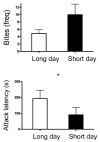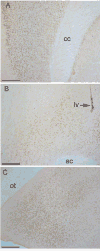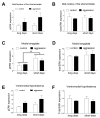Activation of extracellular signal-regulated kinases in social behavior circuits during resident-intruder aggression tests
- PMID: 19874872
- PMCID: PMC2814169
- DOI: 10.1016/j.neuroscience.2009.10.050
Activation of extracellular signal-regulated kinases in social behavior circuits during resident-intruder aggression tests
Abstract
Using a variety of experimental methods, a network of brain areas regulating aggressive behaviors has been identified in several groups of vertebrates. However, aggressive behavior expressed in different contexts is associated with different patterns of activity across hypothalamic and limbic brain regions. Previous studies in rodents demonstrated that short day photoperiods reliably increase both male and female aggression versus long day photoperiods. Here we used immunohistochemistry and western blots to examine the effect of photoperiod on phosphorylation of extracellular signal-regulated kinases 1 and 2 (ERK) in male California mice (Peromyscus californicus) during resident-intruder tests. Phosphorylated ERK (pERK) can alter neuronal activity in the short term and in the long term acts as a transcription factor. In the posterior bed nucleus of the stria terminalis (BNST) males tested in aggression tests had more pERK positive cells when housed in short days but not long days. This result was replicated in western blot analyses from microdissected BNST samples. In the medial amygdala (MEA), immunostaining and western analyses showed that pERK expression also was generally increased in short days. Immunostaining was also used to examine phosphorylation of cyclic AMP response element binding protein (CREB). CREB can be phosphorylated by pERK as well as other kinases and functions primarily as a transcription factor. Intriguingly, aggressive interactions reduced the number of cells stained positive for phosphorylated CREB in the infralimbic cortex, ventral lateral septum and MEA. This effect was observed in mice housed in long days but not short days. Overall, these data suggest that different (but overlapping) networks of aggressive behavior operate under different environmental conditions.
Figures







Similar articles
-
Effects of photoperiod and experience on aggressive behavior in female California mice.Behav Brain Res. 2010 Apr 2;208(2):528-34. doi: 10.1016/j.bbr.2009.12.038. Epub 2010 Jan 7. Behav Brain Res. 2010. PMID: 20060017 Free PMC article.
-
Rapid effects of estradiol on male aggression depend on photoperiod in reproductively non-responsive mice.Horm Behav. 2008 Jan;53(1):192-9. doi: 10.1016/j.yhbeh.2007.09.016. Epub 2007 Sep 29. Horm Behav. 2008. PMID: 17976598 Free PMC article.
-
Vasopressin and aggression in cross-fostered California mice (Peromyscus californicus) and white-footed mice (Peromyscus leucopus).Horm Behav. 2001 Aug;40(1):51-64. doi: 10.1006/hbeh.2001.1666. Horm Behav. 2001. PMID: 11467884
-
Testosterone release and social context: when it occurs and why.Front Neuroendocrinol. 2009 Oct;30(4):460-469. doi: 10.1016/j.yfrne.2009.04.009. Epub 2009 May 5. Front Neuroendocrinol. 2009. PMID: 19422843 Review.
-
Neurobiology of escalated aggression and violence.J Neurosci. 2007 Oct 31;27(44):11803-6. doi: 10.1523/JNEUROSCI.3500-07.2007. J Neurosci. 2007. PMID: 17978016 Free PMC article. Review.
Cited by
-
Rapid effects of estrogens on behavior: environmental modulation and molecular mechanisms.Front Neuroendocrinol. 2014 Oct;35(4):447-58. doi: 10.1016/j.yfrne.2014.03.005. Epub 2014 Mar 29. Front Neuroendocrinol. 2014. PMID: 24685383 Free PMC article. Review.
-
MAP/ERK Signaling in Developing Cognitive and Emotional Function and Its Effect on Pathological and Neurodegenerative Processes.Int J Mol Sci. 2020 Jun 23;21(12):4471. doi: 10.3390/ijms21124471. Int J Mol Sci. 2020. PMID: 32586047 Free PMC article. Review.
-
ERK2 contributes to the control of social behaviors in mice.J Neurosci. 2011 Aug 17;31(33):11953-67. doi: 10.1523/JNEUROSCI.2349-11.2011. J Neurosci. 2011. PMID: 21849556 Free PMC article.
-
Rapid Effects of Estradiol on Aggression in Birds and Mice: The Fast and the Furious.Integr Comp Biol. 2015 Aug;55(2):281-93. doi: 10.1093/icb/icv048. Epub 2015 May 16. Integr Comp Biol. 2015. PMID: 25980562 Free PMC article. Review.
-
Comparative Distribution of Relaxin-3 Inputs and Calcium-Binding Protein-Positive Neurons in Rat Amygdala.Front Neuroanat. 2016 Apr 7;10:36. doi: 10.3389/fnana.2016.00036. eCollection 2016. Front Neuroanat. 2016. PMID: 27092060 Free PMC article.
References
-
- Abraham IM, Todman MG, Korach KS, Herbison AE. Critical in vivo roles for classical estrogen receptors in rapid estrogen actions on intracellular signaling in mouse brain. Endocrinology. 2004;145:3055–3061. - PubMed
-
- Ahima RS, Harlan RE. Charting of Type-Ii Glucocorticoid Receptor-Like Immunoreactivity in the Rat Central-Nervous-System. Neuroscience. 1990;39:579–604. - PubMed
-
- Albert DJ, Brayley KN, Milner JA. Connections from the lateral septum modulating reactivity in the rat. Physiology & Behavior. 1978;21:761–767. - PubMed
-
- Annen Y, Fujita O. Septal lesions and biting attacks in rats bidirectionally selected for emotionality. Behav Neural Biol. 1985;43:132–142. - PubMed
-
- Beata A. Diagnosis and treatment of aggression in dogs and cats. In: Houpt KA, editor. Recent advances in companion animal behavior problems. Ithaca, New York: International Veterinary Information Service; 2001.
Publication types
MeSH terms
Substances
Grants and funding
LinkOut - more resources
Full Text Sources
Miscellaneous

